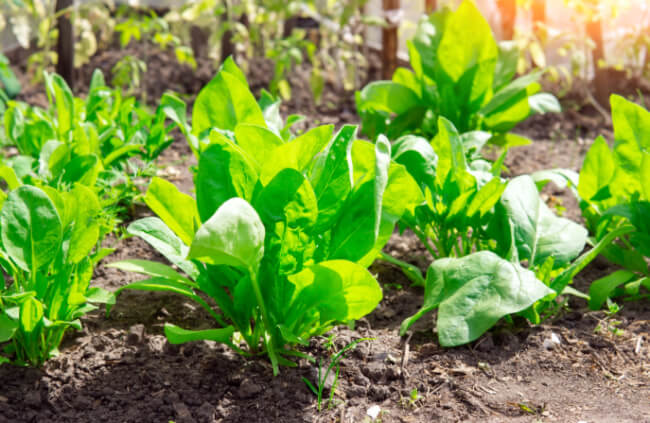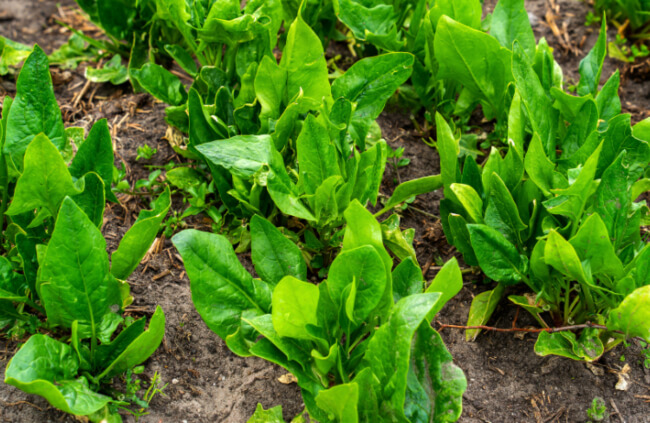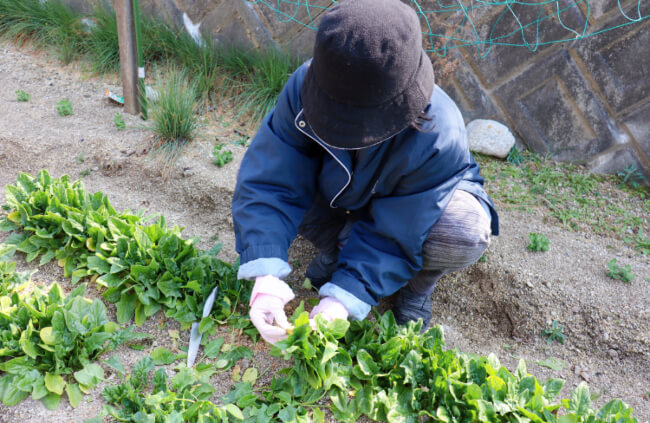The thought of eating spinach might take you back to your childhood days, when eager and well-meaning parents encouraged eating this super food to grow big and strong. Hopefully as an adult you can find a new appreciation for this green vegetable that can be rather delicious and boost your immunity too.
Dive into our detailed guide on English Spinach, covering everything you need to know about growing this plant at home. Learn essential care tips for maintaining its health and explore the culinary and health benefits of incorporating English Spinach into your meals.
More...

Family: | Amaranthaceae |
|---|---|
Genus: | Spinacia |
Species: | S. oleracea |
Common Names: | English spinach, Common spinach |
Origin: | North America, Central America, South America, Asia |
Location: | Indoor or outdoor |
Type: | Annual, vegetable |
Growth: | Up to 30 cm tall and wide |
Sun requirements: | Full sun, part sun |
Foliage Colour: | Bright green |
Flower Colour: | Yellow-green |
Flowering: | Summer |
Edible Parts: | All parts of spinach are edible, including the leaves, stems, and roots |
Maintenance level: | Low |
Poisonous for pets: | No |
How to Grow Spinach in Australia
English spinach, botanically known as Spinacia oleracea, is a power packed green leafy vegetable that thrives in cool weather. The plant grows upright and creates yellow to green flowers in warm weather, eventually turning into seeds.
This vegetable is easy to grow and you can begin harvesting the leaves of your English spinach within a few weeks. The younger leaves work well in a salad and the more mature leaves are great steamed and mixed with other veggies.
The best time to plant English spinach is during spring or autumn and it will grow well in almost all the cooler parts of Australia.
How to Propagate Spinach

Propagating English Spinach from Seeds
Growing this spinach plant is usually from seeds. You can collect the necessary seeds for your English spinach by allowing an existing spinach plant to flower which happens at the end of the growing season.
You’ll need to wait for the flowers to finish blooming and you’ll see the formation of seeds that follow. You can cut off the flowers at the base and then hang them upside down so they can dry out. It might be helpful to place a container or bag underneath the flowers to help collect the seed.
When the flower has dried out completely, move your hand all the way along the stalk so that you capture all the seed and then separate the seeds from the dry leaves using a sieve. You can keep the seeds in a dry place to be sown the following year.
When you are ready to plant your English spinach seeds, loosen up the soil first and add compost and manure. Plant the seeds at no more than 2 cm deep and you can space them 5 cm apart. Press down the soil, and then water.
The soil needs to stay moist to help germination. It usually takes a week or two before you see signs of growth. Take care that the soil doesn’t become waterlogged but it also shouldn’t dry out.
English spinach grows best in cooler weather and the plants will need regular watering if the weather becomes dry. You can add mulch to the soil when the plants get to a height of 5 cm.
English Spinach Propagation from Stems
It is also possible to propagate English spinach using stems from an existing plant. When you are harvesting a mature spinach plant, you can look out for a stem with roots and gently remove it from the ground so you don’t disrupt the roots.
Plant the pulled stem in a potting mix and then water it so that the moisture level is even. You can test for the formation of new roots by gently pulling on the planted stem. When there is resistance to your pulling, you have confirmation of a good root system.
Best Conditions for Planting Spinach

Light Preference
Your English spinach needs to be planted in a spot where it can get full sun or part shade. Ideally it needs about 3 to 4 hours of direct sun daily but a good guideline is to provide the plant with full sun during the cold months and partial shade in the warmer months.
Soil
English spinach enjoys a soil that is loamy, has plenty of organic matter, and is well-draining. A neutral soil pH is best.
Watering Spinach
English spinach should be watered often so that the soil stays moist. It should never be soggy. The best way to achieve this is watering a few times during the week instead of one big watering once per week.
You can also add mulch around the plant to lock in soil moisture. When the weather is hot and dry, it’s even more important to give regular water.
Temperature and Humidity
English spinach grows best in a temperature range of 10 to 15°C. A light frost is okay. In terms of humidity, just ensure that the soil stays moist enough and that the plant has enough air flow.
Fertiliser
English spinach grows quickly which means it needs some extra feeding. When you plant your spinach, you can add in a fertiliser that is high in nitrogen. This will help your plant to produce healthy leaves.
You can add fertiliser throughout the growing season. Good options are fish emulsion, soy meal, and seaweed solution.
Pruning English spinach
The best way to keep your English spinach plant growing abundantly is to harvest its leaves throughout the entire growing season. Removing the flowers from the plant prevents them from turning into seed.
Culinary Use of English Spinach
You’ll recognise English spinach in particular thanks to its small and flat leaves that are shaped like spades, and green veins. When you cook English spinach, it actually enhances the benefits of the antioxidants found in this leafy vegetable. It’s loaded with vitamins C, E and B6. These enhance immunity and keep the blood healthy.
Cooking also makes more magnesium and iron available for the body to absorb. Spinach has plenty of iron and dietary fibre. The antioxidant beta-carotene in particular fights off heart disease and lung cancer.
English spinach also contains lutein which is great for preventing cataracts and degeneration of the eyes.
How to Use Spinach
English spinach should be washed well before eating to get rid of sand and any other dirt. You can cut the roots and then rinse in cold water. Baby spinach leaves in particular can be enjoyed raw, but you can also use the leaves in soups, baked goods or sauté for a delicious dish. English spinach pairs well with feta, garlic, eggs, and chicken.
The best way to get all the flavour and nutrition from English spinach is to lightly steam it or you can also toss it in a dry and heated pan. Wash the leaves first and then pop them into the pan. Once they have wilted they are ready to serve.

How to Harvest Spinach
You can harvest English spinach leaves often and we recommend using a few leaves from each plant that you have instead of only harvesting from one each time. You can usually harvest English spinach within a period of 4 to 6 weeks after the seeds have been planted.
Leaves can be harvested with garden scissors. Harvest the leaves from the outside in, so you start with the old leaves on the outside and the younger inner leaves of the plant remain to keep growing for later harvest.
How to Store Spinach
You can store spinach in the fridge for up to 10 days. It should be in an airtight container on its own. You can also opt to freeze your English spinach. Wash the leaves and then let them dry before popping them into a freezer bag. Be sure to use the spinach within 3 to 6 months.
Common Spinach Pests and Diseases
Downy mildew (blue mould)
Symptoms of downy mildew include spots on the leaves that are light green to yellow. The spots also have a soft white growth on the lower end of the spots. Eventually these become brown and dry and the older leaves are usually the first to be affected.
You can treat with a copper or sulphur based fungicide. You need to ensure that both the top and bottom of the leaves are well coated and wet. Follow up with some neem oil to prevent any more damage to the plant.
Fusarium wilt
Signs of Fusarium wilt include stunted growth and yellowing of the plant. You’ll notice wilting, with dry and yellow leaves. It is possible for this fungus to kill a plant entirely.
Harnessing the power of the sun is a great way to treat your soil. You’ll need to first get rid of any infected plants. Once this is done, cover up the soil with a black plastic groundsheet or covering and the sun will then create a level of heat that kills off the fungus.
Aphids
This pest sucks the sap from your plant which causes abnormal growth and a plant that seems to be struggling. The honeydew that the aphids secrete then creates sooty mould. Treat your plant by spraying the leaves with a mixture of water and dishwashing soap. Follow this process every 3 days for about 2 weeks.
Read our guide on how to get rid of aphids for more details.
English Spinach Frequently Asked Questions

What are the different kinds of spinach that exist?
When we talk about spinach, it’s usually referring to English spinach which favours cool weather, but the name is also used for other green veggies that grow in warmer weather.
These include Chinese spinach (Amaranthus sp) and French spinach (Atriplex hortensis) which are related to English spinach. There is also New Zealand spinach (Tetragonia sp), Egyptian spinach (Corchorus sp) and Indian, Ceylon or Malabar spinach (Basella sp).
How do I grow spinach in a pot?
Growing English spinach in a pot is ideal for harvesting in the kitchen. It’s also a great way to protect your plant from being enjoyed by pests and insects. The pot should be 25 to 30 cm deep and wide, with drainage holes.
Why is spinach considered a brain food?
Spinach is great for the brain. It contains high amounts of lutein which flushes out toxins from the brain and also protects it from degenerating with age.
What is the history of English spinach?
Spinach first arrived in England and France during the 14th century, coming from Spain. It became a commonly used vegetable because it would grow in the spring time when more local fresh veggies were not yet ready.
When Catherine de' Medici became queen of France in 1533, she made spinach popular again. The queen loved spinach to the point where she ate it with every meal. She was born in Florence and that is why dishes made today that contain spinach are called Florentine.
Spinach also served an important function during the First World War. French soldiers who were suffering from heaving bleeding would be given a mixture of wine and spinach juice.
What does the scientific name for spinach, Spinacia oleracea, mean?
It means “spiny vegetable of cultivated land”.
Is English spinach something I can eat every day?
While spinach does have plenty of health benefits, it does also contain a high quantity of oxalates or oxalic acid. This compound can affect the body’s ability to absorb calcium in particular.
Learn more about our amazing plant kingdom and how to harness the power of a green thumb for your own garden. Sign up for our newsletter.
Wrapping Up Our English Spinach Guide
Popeye, the well-known cartoon character, was onto something when he ate a can of spinach to get strength and energy. Spinach has really earned itself the title of a super food, considering its cultivation as a traditional medicinal plant, treating fevers and inflammation.
I continue to be fascinated by the English spinach and its many uses, including being a natural food dye because of the amazing green colour (thank you chlorophyll).
Published on July 20, 2023 by Gary Clarke
Last Updated on February 25, 2024




